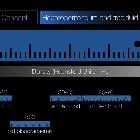Hounsfield unit



Hounsfield units (HU) are a dimensionless unit universally used in computed tomography (CT) scanning to express CT numbers in a standardized and convenient form. Hounsfield units are obtained from a linear transformation of the measured attenuation coefficients . This transformation (figure 1) is based on the arbitrarily-assigned densities of air and pure water:
- radiodensity of distilled water at standard temperature and pressure (STP) = 0 HU
- radiodensity of air at STP = -1000 HU
Note: STP = standard temperature is 0 °C and pressure is 10 pascals (i.e. sea-level).
This results in a scale running from -1000 HU for air to +~2000 HU for very dense bone (cochlea) and over 3000 for metals .
Generally, CT images, therefore, use 12-bit images able to store values between −1024 to 3071 . How these values are displayed is then determined by the application of specific window and level values.
The software of all CT scanners and PACSs has the ability to measure the density of a region of interest (ROI) electronically overlaid the image.
Hounsfield units are measured and reported in a variety of clinical applications. One well-known use is the evaluation of the fat content of the liver, with fatty liver diagnosed by the presence of a liver-to-spleen ratio <1.0 or 0.8 . Other less common uses include assessing bone mineral density (BMD) , predicting the presence of anemia , and guiding the management of kidney stones .
No equivalent to Hounsfield units exists in any other form of structural imaging.
History and etymology
Hounsfield units are named after Sir Godfrey Hounsfield, the Nobel prize winner and inventor of CT.
Siehe auch:
und weiter:

 Assoziationen und Differentialdiagnosen zu Hounsfield Einheiten:
Assoziationen und Differentialdiagnosen zu Hounsfield Einheiten:
